Contact Caravaca Tourist Office +34 968 70 24 24
or send an Email
Click Here

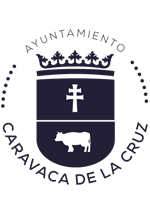

















Contact Caravaca Tourist Office +34 968 70 24 24
or send an Email
Click Here
This site uses cookies. By continuing to browse the site, you are agreeing to our use of cookies. Read More (privacy and cookie policy)


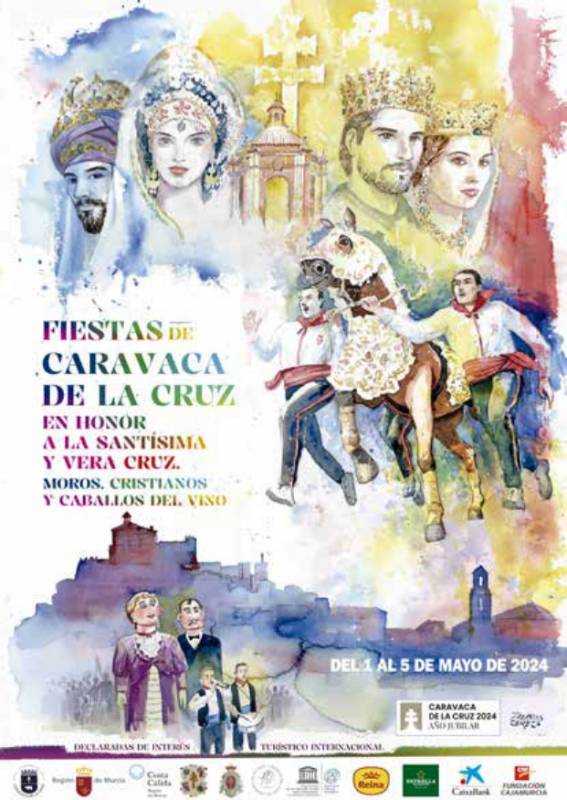 The Running of the Wine Horses is one of the most exciting and unique fiesta activities in the Region of Murcia and takes place every year on 2nd May. However, this one event, which enjoys International Tourist Interest status and has been recognized as an Event of Intangible Cultural Heritage by UNESCO, is just a small part of the extraordinary fiestas which combines religion, pride, tradition, history and legend to create an astonishing blend which is justifiably famous.
The Running of the Wine Horses is one of the most exciting and unique fiesta activities in the Region of Murcia and takes place every year on 2nd May. However, this one event, which enjoys International Tourist Interest status and has been recognized as an Event of Intangible Cultural Heritage by UNESCO, is just a small part of the extraordinary fiestas which combines religion, pride, tradition, history and legend to create an astonishing blend which is justifiably famous.
At the centre of the fiestas is the legend of the Vera Cruz (True Cross), which has protected the city since the 13th century: this is the reason why Caravaca is a holy city, on a par with Rome and Jerusalem.
Built around the cross are legends which tell of conflicts between the Moors and Christians who fought for dominance of this area, and the act of heroism which inspired the running of the wine horses. This story has it that at some point in the 13th century the Christians in Caravaca were under siege from Moorish armies camped at the base of the hill, weak and dying of thirst as their water supply had been contaminated.
However, a group of brave Knights Templar managed to locate some wine, which they loaded onto the backs of their horses and the animals ran at full pelt up the slope to provide relief with knights (or runners) clinging on. Inside the Basílica the Holy Cross of Caravaca was bathed in the wine, and this miraculously healed the sick and enabled them to continue their resistance.
This daring run of the horses is now recreated every May 2
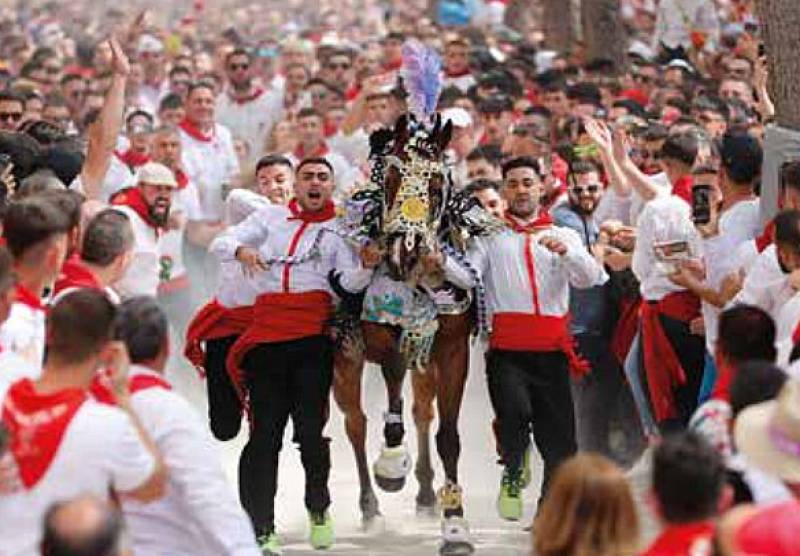 Throughout the week locals (and the horses) don glorious costumes and take part in mock battles, re-enactments of the important events which took place in the city and parades through the streets, providing a riot of colour with shining gold and flashing swords. The three main participating groups represents the Moors, the Christians and the Wine Horses.
Throughout the week locals (and the horses) don glorious costumes and take part in mock battles, re-enactments of the important events which took place in the city and parades through the streets, providing a riot of colour with shining gold and flashing swords. The three main participating groups represents the Moors, the Christians and the Wine Horses.
The program for the 2024 Fiestas de la Cruz in Caravaca includes the following:
Wednesday April 24
17.15: Arrival of the Tío de la Pita, a kind of Pied Piper figure, and a group of “giants and big heads” who spend the days prior to the fiestas announcing their imminent start. Departing from Plaza Paco Pim, the Tío de la Pita parades to Plaza del Arco to be greeted from the balcony of the Town Hall. This is followed by a children's party and snacks.
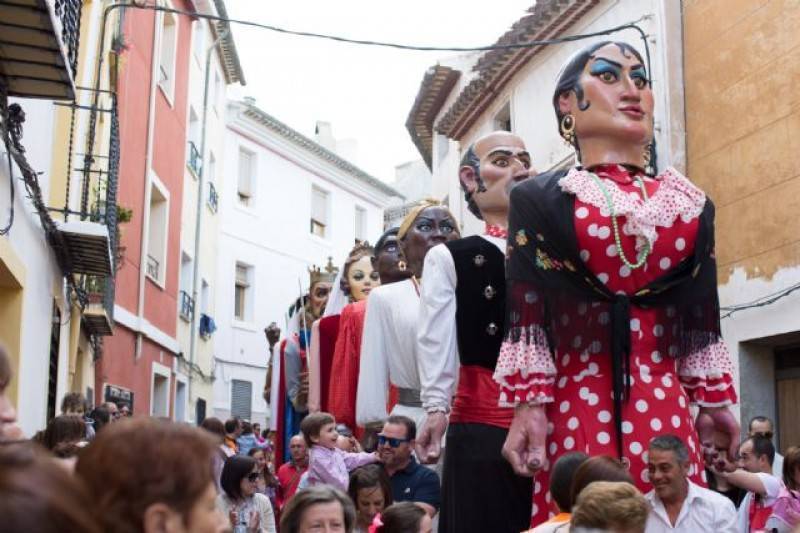 April 26 to 29
April 26 to 29
17.00: Fun and games for children in the Placeta del Santo.
18.00: Each day between Thursday and Monday there are parades reminding residents and visitors that the fiestas will be starting soon.
Sunday April 28
21.00: Official opening speech of the Fiestas by Miguel Sánchez Robles.
Monday April 29
9.30: Colecta Official, with the participation of military, local authorities and local ecclesiastical figures.
Tuesday April 30
7.00: The town awakens to the ringing of church bells and a procession through the town, along with firecrackers.
Midnight: On the evening before the national holiday of 1st May families and friends gather in and around the Plaza de los Caballos del Vino to eat traditional “migas”, a calorific combination of flour and olive oil, served with meat or fish. At these celebrations it is prepared in an enormous frying pan over an open fire. This is a night of song and celebration as good local wine fortifies the population in preparation for the week ahead. A major migas-making competition, the Certamen de Migas del Sureste, takes place in the Plaza de los Caballos del Vino.
Wednesday May 1
The horses come into Caravaca without their embroidered coats to compete for the title of "best undressed horse". Testosterone levels rise amongst the young bloods, this also being the perfect opportunity to show off their skill and daring as they handle their horses.
The shawls which will be worn by the horses the following day are on display all day at 4 venues: Calle Mayrena, the Plaza del Templete and the Casa de la Cultura Emilio Sáez.
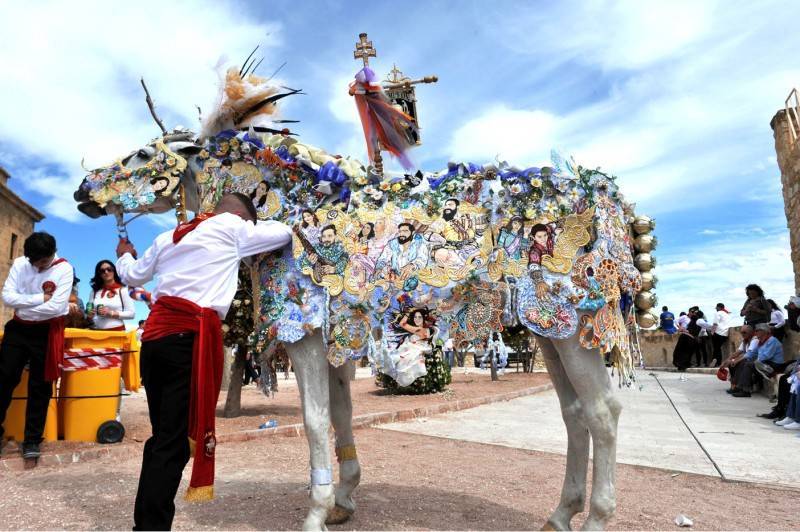 11.00: The participants in the fiestas gather in the Glorieta, before following a route to the Santuario for a special open-air service and floral offering. New members of the Cofradías are awarded a replica cross in a Holy Mass which takes place at 12.00.
11.00: The participants in the fiestas gather in the Glorieta, before following a route to the Santuario for a special open-air service and floral offering. New members of the Cofradías are awarded a replica cross in a Holy Mass which takes place at 12.00.
16.00: The peñas assemble in the Plaza de Paco Pim, then move up to the Plaza de los Caballos del Vino for the competitions to begin, running their horses up from the Templete minus their embroidered shawls. Prizes are awarded to the most skilled riders and the best horses.
19.00: Satirical musical entertainment in the Plaza del Arco, a throwback to the jongleurs of the Caballeros de San Juan de Jerusalén, wandering troubadours of Medieval Europe.
20.30: Music bands enter town from the Plaza Paco Pim and parade to the Plaza del Arco.
22.30: The Himno a Caravaca (the city’s anthem) is sung by the Agrupación Musical de Caravaca de la Cruz.
Thursday May 2, The Running of the Wine Horses
This is the day when the Wine Horses recreate the legend in which the Knights Templar braved the Moorish armies besieging the castle to bring wine up the hill to the thirsty inhabitants who were barricaded within.
Visiting is quite an experience and it must be remembered that the streets are hugely overcrowded and can be quite dangerous – especially if the streets are damp with rain. The horses run up the hill in front of the Basílica through a crowd of thousands and whips are used, and it can be a frightening experience!
On the other hand, it is a thrillingly magnificent spectacle!
60 horses are dressed in spectacular embroidered mantels, the fruit of a year’s work by dedicated peña members and run up the hill to the sanctuary one by one, in a race against the clock. Normally, each run is over in less than 10 seconds.
4.00: The church bells of the Parroquia del Salvador church ring out to welcome the day.
7.00: More noise as firecrackers are let off and church bells are rung throughout the city.
9.00: Holy Mass is celebrated at the Templete, in the presence of the groups of Moors, Christians and Caballos de Vino, in celebration of the Appearance of the Holy Cross. Flowers are then taken to the church of San José in Calle Mayor, where they remain on display all day.
9.30: Start of the parade of the peñas and wine horses in the Plaza del Templete. The horses walk slowly along this route one by one, giving onlookers a chance to see their embroidered mantles. It's very informal and the horses take their time, stopping en-route as their owners talk to friends. Route: Cuesta de la Simona, Calle del Hoyo, Plaza de los Caballos del Vino, Canalejas, Vidrieras, Gregorio Javier, Plaza del Arco and Gran Via, returning to the Templete. This is a great chance to see the shawls of the horses close up.
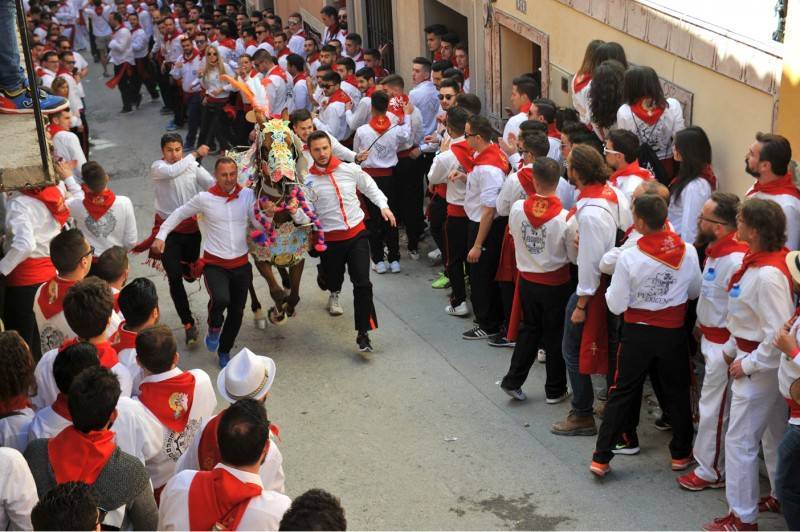
12.00: Parade of the Moors and Christians. This parade is slightly less formal, and runs from the Templete via Corredera, Poeta Ibáñez, Canalejas and Gregorio Javier to Plaza del Arco, where it picks up the official authorities and then carries on through Puentecilla, Gran Via, Maruja Garrido, Santisimo, Rafael Tejeo and Mayor to the Basílica de la Vera Cruz.
13.15: The Moors and Christians meet the Caballos del Vino at the intersection of Calles Santísimo and Rafael Tejedo and head towards the Iglesia del Salvador. Here the Hermano Mayor collects the traditional floral offering which is then ceremoniously handed over to the Mayor of Caravaca at the foot of the Cuesta del Castillo, the bottom of the hill up which the horses will run. This is then offered to the Santísima Cruz in the Basilica, followed by a blessing of the wine and the flowers.
14.00: The running of the wine horses in the Cuesta del Castillo. The event lasts between two and three hours. Each horse has to be brought to the bottom of the cuesta and steadied before it starts to run, and this can take time.
When a horse starts the words "Caballo en carrera" come over the loudspeakers, warning the crowd to part and make way. In less than 10 seconds it´s over, although standing in the crowd it feels like an eternity until those lower down the hill suddenly move and the horse bursts through into the open space, the crowd immediately closing behind it, willing it to finish with all 4 runners still attached. Many lose at least one runner and dust-caked runners crying on the floor is a common sight as some are totally overwhelmed by the disappointment.
After the running, the winners of the best dressed horse and the race itself are announced inside the grounds of the castle.
A safe alternative to joining the heaving throng is to watch on television in one of the bars in the city below!
20.30: Simulated combat in the Cuesta del Castillo in which the Moors take the fortress.
21.00: The Vera Cruz (the cross of Caravaca) is solemnly paraded from its sanctuary in the Basilica to the church of El Salvador, accompanied by the Moors and Christians. The Cross staus here for the night and the following couple of days.
Friday May 3, the Festividad de la Santísima Vera Cruz
11.00: Mass in the church of El Salvador, presided over by the Bishop of Cartagena.
12.00: Children’s procession of the Moors and Christians, from Plaza Paco Pim via Gran Vía to the Plaza del Arco. From here the children's Caballos del Vino head to the Basilica where prizes are given to the participants.
17.15: The Solemne Procesion del Baño, in which the Vera Cruz (the True Cross) from the Plaza del Arco to the Templete. The cross then leaves from the Parroquia El Salvador arriving at the Cuesta de la Cruz at approximately 20.30.
18.00: Holy Mass in the Parroquia de El Salvador with veneration of the Cross. The cross is then taken to the Templete and at around 20.30 there is then a parley between the Christian King and Moorish sultan, followed by a mock battle.
21.00: The Bathing of the Cross and the Blessing of the Waters. The procession continues to the Parroquia del Salvador.
The procession ends with fireworks outside the castle.
Saturday May 4
8.00: Holy Mass at the Iglesia de El Salvador, worshipping the Vera Cruz.
8.45: The Cruz de Impedidos, in which the Cross travels from the Ermita de Santa Elena to the Monasterio de Santa Clara, where it is received in a traditional ceremony in which thousands of Rose petals are strewn from the gallery of the monastery, bathing the cross in symbolic floral offerings. The holy relic is then taken to the church of San Francisco.
10.30: Children’s wine horses parade from Plaza Paco Pim via Gran Vía and Plaza del Arco to the Basílica, where prizes are awarded.
16.30: Holy Mass in the church of San Francisco and the cross continues on its journey to visit the sick, with Mass celebrated en route, ending in the church of La Purísima Concepción with another Mass at 19.00.
19.30: The grand parade of the Moors and Christians takes place, a spectacular display of robes and costumes. This is the big parade of the week, starting in Avenida de la Constitución and continuing along Gran Vía to Plaza del Arco. This is one of the biggest and most spectacular Moors and Christians parades in the Region of Murcia but there are relatively few onlookers as such a high percentage of the town are taking part!
Sunday May 5
8.00: Mass in the church of La Purísima Concepción.
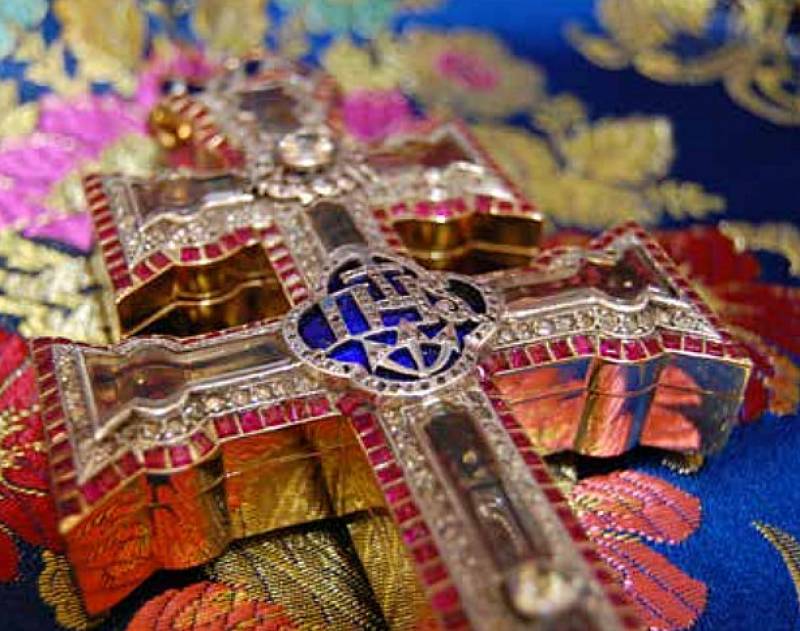 8.45: Cruz de Impedidos. The cross is taken to the Monastery de Nuestra Señora del Carmen, where it is greeted by the Carmelite order and then transferred to the Iglesia del Salvador.
8.45: Cruz de Impedidos. The cross is taken to the Monastery de Nuestra Señora del Carmen, where it is greeted by the Carmelite order and then transferred to the Iglesia del Salvador.
17.00: Mass is celebrated in the Parroquia de El Salvador.
18.00: The final return of the Cross from the Parroquia del Salvador. A procession accompanies the Cross on its journey back to the Sanctuary in the Basilica. On its arrival the traditional blessing of the town and surrounding countryside takes place.
Midnight: Fireworks signal the end of the celebrations.
Further information about Caravaca and the Holy Jubilee Year in 2024 is available from the tourist office (Plaza de España, 7, telephone 968 702424, email turismo@caravacadelacruz.es).
Or for more local information, including the Holy Jubilee Year as well as local news and what’s on, go to the home page of Caravaca Today.
 More information about the places of interest which can be visited in the municipality of Caravaca de la Cruz, along with what's on and local news can be found in the Caravaca Today.
More information about the places of interest which can be visited in the municipality of Caravaca de la Cruz, along with what's on and local news can be found in the Caravaca Today.
Caravaca de la Cruz, in the north-west of the Region of Murcia, is one of only 5 Holy Cities in the Roman Catholic world, a centre of pilgrimage, along with Rome, Jerusalem, Santiago de Compostela and Santo Toribio de Liebana, and is home to the Cross of Caravaca, the Vera Cruz.
The status of Holy City was bestowed by Pope John Paul II in 1998, granting the City a Permanent Jubilee year every 7 years for perpetuity, the first one held in 2003 and the next in 2024.

The strategic and natural advantages of Caravaca de la Cruz have attracted the attention of settlers for more than 800,000 years, the Cueva Negra yielding remains of Homo Heidelbergensis, forbears of the Neanderthals and the municipality also houses important archaeological remains from the Argaric, Iberian and Roman cultures. many of these can be seen in the Municipal Archaeological Museum.
 As a border town caught between the Catholic forces of Castille and the last remaining Moorish stronghold in Spain, Granada, Caravaca had a turbulent medieval history, but it was during this period that the legend of the Cross of Caravaca was born, bringing the religious orders which shaped the structure of Caravaca today, with its impressive hilltop castle and eclectic collection of churches and monasteries, religious tourism today being a backbone of the town´s economy.
As a border town caught between the Catholic forces of Castille and the last remaining Moorish stronghold in Spain, Granada, Caravaca had a turbulent medieval history, but it was during this period that the legend of the Cross of Caravaca was born, bringing the religious orders which shaped the structure of Caravaca today, with its impressive hilltop castle and eclectic collection of churches and monasteries, religious tourism today being a backbone of the town´s economy.
Caravaca de la Cruz is a municipality with important natural resources, including extensive forests, part of which have protected status due to their wealth of flora and fauna, and due to the abundant water supplies is also a major area for canned fruit production, apricots in particular being an important crop.
 Caravaca is renown for its important May Fiestas, held in honour of the Vera Cruz, which also incorporate the Moors and Christians celebrations and the Running of the Wine Horses.
Caravaca is renown for its important May Fiestas, held in honour of the Vera Cruz, which also incorporate the Moors and Christians celebrations and the Running of the Wine Horses.
Caravaca de la Cruz is also the home of Europe´s largest collection of ethnic instruments at Barranda, the Museo de Música Étnica Barranda and is the location of the Barranda festival de Cuadrillas, which celebrates the Region's ethnic music traditions.
The municipality is home to around 26,000 inhabitants and shares boundaries with Moratalla, Cehegín, Lorca, Puebla de Don Fadrique in the province of Granada and Vélez-Blanco in the province of Almería.
Opening times:
Weekdays: 10.00 to 14.00 and 16.30 to 19.30
Saturdays: 10.30 to 14.00 and 16.30 to 19.30
Sundays and public holidays: 10.30 to 14.00
Click for map, Caravaca de la Cruz Tourist Office
